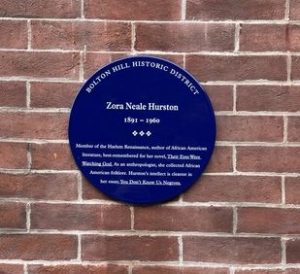
Bolton Hill’s Blue Plaques Task Force this month announced the addition of five new markers on residences that have been in the past homes to people who made a significant difference to the quality of life in Baltimore or on a larger stage.
Lynn Cripps and Barbara Blumberg, who chaired the task force for BHCA, announced that the blue markers that mimic similar building history plaques in London neighborhoods have been approved and installed at these addresses in honor of their former residents:
- 226 W. Lafayette Ave., honoring writer-anthropologist Zora Neal Hurston, a member of the Harlem Renaissance best remembered for her novel Their Eyes Were Watching God.
- 1310 Rutter St., honoring Arthur Sherwood, founder of the Chesapeake Bay Foundation and first executive director of the Baltimore Community Foundation.
- 121 Mosher St., Reuben Kramer, an internationally recognized sculptor and artist whose statue of Supreme Court Justice Thurgood Marshall is at the federal courthouse downtown.
- Also 121 Mosher St., Perna Krick a painter and sculptor who, with her husband Reuben Kramer founded Fellowship House, the first desegregated art school in Maryland.
- 1419 Eutaw Pl., Capt. Frederick William Hamilton Murrell who in 1887 captained a Baltimore-bound cargo ship that encountered a sinking Danish vessel, the Danmark, and led the rescue of its 735 passengers.
The Blue Plaques were the brainchild of the late longtime Bolton Hill resident and historian Frank Shivers and his neighbor Polly Duke. The first plaques were created in the late 1990s and included residences once occupied by, among others, writer F. Scott Fitzgerald, Greek mythology expert Edith Hamilton, entertainer Gary Moore, President Woodrow Wilson and Dr. Jesse Lazear, the Johns Hopkins Hospital malaria and yellow fever expert.
In 2018, 13 additional plaques were authorized. Altogether there are now 42.
BHCA oversees the selection, but the residence owners must agree and pay for the plaques, which are crafted individually in Washington State. The criteria set by this year’s committee required that the honored person must have lived in the neighborhood for at least one year and, in their lifetimes, made a significant contribution to society. They also had to have been dead for two decades or more. The plaques must be placed on the actual building where the honoree lived. There were 22 nominees.
According to the co-chairs, in selecting this crop of honorees, special attention was given to women and other under-represented groups. Other members of the Blue Plaque Task Force were Bolton Hill residents Louis Bernstein, Margaret DeArcangelis, Charlie Duff, Gayle Guilford and Johns Hopkins.
